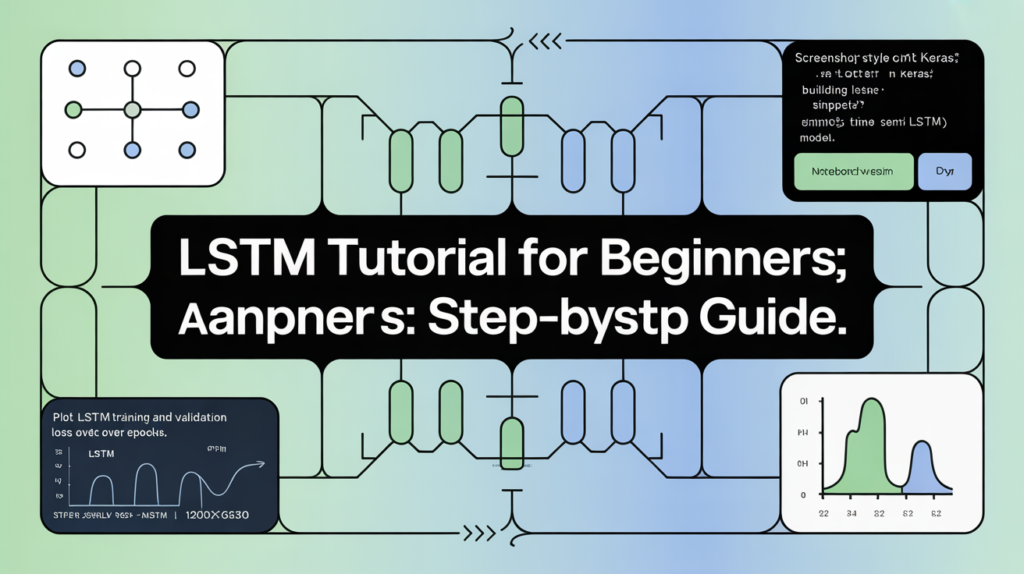LSTM Tutorial for Beginners: Step‑by‑Step Guide

Introduction to This LSTM Tutorial for Beginners
If you’re searching for an lstm tutorial for beginners, you’re in the right place. This guide is crafted to teach you—from scratch—what an LSTM network is, why it matters, and how to build one using Python, Keras, or TensorFlow. With simple explanations, practical examples, and a friendly tone, this tutorial helps you get hands-on fast.
We’ll cover essential concepts, environment setup, your first LSTM model for a time-series or text task, and best practices to avoid common mistakes. By the end, you’ll be confident building and debugging an LSTM with real-world applications.
1. Setup and Environment
Before diving into code, let’s set up your workspace.
- Python 3.8+ installed
- Virtual environment using
venvorconda - Install dependencies:
pip install numpy pandas matplotlib tensorflowThis lstm tutorial for beginners python setup ensures you have everything ready for building LSTM models in Keras and TensorFlow.
2. Understanding LSTM Basics
What Is an LSTM?
An LSTM (Long Short-Term Memory) is a type of recurrent neural network that can learn long-range dependencies. It uses gates—input, forget, and output—to control information flow over time steps, overcoming the vanishing gradient problem. This section of the lstm tutorial for beginners introduces the core concept in simple terms.
Why Use LSTM?
- Suited for time‑series and sequence data
- Learns context over many timesteps
- Interpretable gating mechanics
- Works well in Python, Keras, and TensorFlow environments
3. Your First LSTM Model (Time-Series Example)
Preparing the Data
We’ll start with a simple synthetic time‑series:
import numpy as np
data = np.sin(np.arange(0, 100, 0.1))
X, y = [], []
for i in range(len(data)-10):
X.append(data[i:i+10])
y.append(data[i+10])
X = np.expand_dims(np.array(X), axis=2)
y = np.array(y)Building the LSTM Model (using Keras)
from tensorflow.keras.models import Sequential
from tensorflow.keras.layers import LSTM, Dense
model = Sequential([
LSTM(50, input_shape=(10, 1)),
Dense(1)
])
model.compile(optimizer='adam', loss='mse')
model.fit(X, y, epochs=20, validation_split=0.2)This straightforward code exemplifies the lstm tutorial for beginners keras approach.
4. Example Project: Text Classification with LSTM
Dataset and Tokenization
Use a sample dataset like IMDb ratings:
from tensorflow.keras.datasets import imdb
from tensorflow.keras.preprocessing.sequence import pad_sequences
(X_train, y_train), (_, _) = imdb.load_data(num_words=5000)
X_train = pad_sequences(X_train, maxlen=200)Model Definition
model = Sequential([
Embedding(input_dim=5000, output_dim=64),
LSTM(64),
Dense(1, activation='sigmoid')
])
model.compile(optimizer='adam', loss='binary_crossentropy', metrics=['accuracy'])
model.fit(X_train, y_train, epochs=5, validation_split=0.2)This example demonstrates an lstm tutorial for beginners nlp use case.
5. Key Best Practices
- Normalize and scale input data for smoother convergence.
- Use early stopping to prevent overfitting.
- Dropout and recurrent dropout can stabilize training.
- Monitor loss curves and accuracy, and visualize them using
matplotlib. - Evaluate final predictions with appropriate metrics—MSE for regression, accuracy or F1 for classification.
6. Training and Loss Visualization
Plot and analyze training vs. validation loss:
history = model.history.history
plt.plot(history['loss'], label='Train')
plt.plot(history['val_loss'], label='Validation')
plt.legend()
plt.title('LSTM Training and Validation Loss')
plt.show()Visualizing training progress helps troubleshoot common issues—an important step in any lstm tutorial for beginners with examples.
7. Common Mistakes & Troubleshooting
| Mistake | Correction |
|---|---|
| Forgetting to scale data | Use MinMaxScaler for normalization |
| Training too fast | Reduce learning rate or batch size |
| Overfitting validation loss increases | Add dropout or early stopping |
| Vanishing gradients | Clip gradients or use smaller sequences |
Part of an lstm tutorial for beginners complete guide is learning to debug effectively.
8. More Project Ideas You Can Try
- Stock price prediction with historical data
- Weather forecasting using temperature and humidity time-series
- Sentiment analysis on tweets or product reviews
- Sequence generation or text completion with LSTM networks
These are classic lstm tutorial for beginners step by step projects to build your skills.
Links & References
- Learn more about TensorFlow’s Recurrent layers: tensorflow.org
- Keras documentation on LSTM: keras.io
- Hands‑on book: Deep Learning with Python by François Chollet
✅ Frequently Asked Questions (FAQs)
- What programming languages are used in this tutorial?
We use Python, with both Keras and TensorFlow, which are beginner‑friendly frameworks. - Can I use this LSTM for both time-series and NLP?
Yes! This guide includes both a time‑series example and a text classification example using standard datasets. - How do I avoid overfitting in LSTM models?
Use dropout, early stopping, and monitor the validation loss curve carefully. - Is LSTM good for real‑time applications?
Absolutely. LSTM’s sequential processing and small footprint make it well‑suited for streaming data and deployment on edge devices. - Where can I find more example datasets?
Try UCI Machine Learning Repository, Kaggle, or TensorFlow Datasets for free time-series and text corpora.
🧩 Get Started: Check Out These Guides on Python Installation
Working with LSTM neural networks often means setting up Python correctly, managing multiple versions, and creating isolated environments for your deep learning experiments.
To make sure your LSTM models run smoothly, check out these helpful blogs on Python installation:
📌 Python 3.10 Installation on windows
📌 Python 3.13 (latest) installation guide – easy and quick installation steps
Discover more from Neural Brain Works - The Tech blog
Subscribe to get the latest posts sent to your email.
